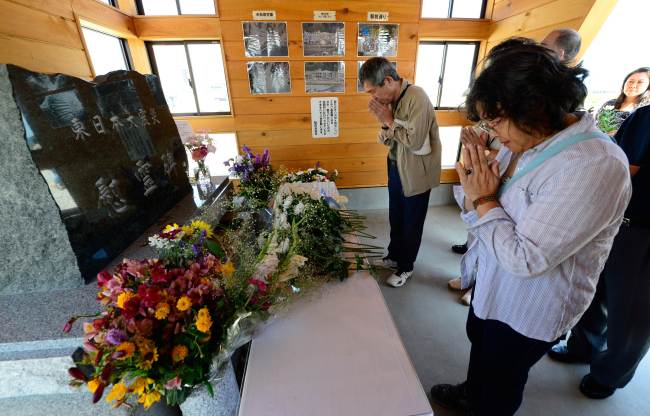RIKUZENTAKATA, Japan (AFP) ― Before the huge tsunami virtually wiped it off the map in 2011, Rikuzentakata’s pristine beach and luxuriant pine forests were a well-worn stop on Japan’s tourist trail.
Now the visitors are coming back, but this time they want to see the devastation and the monuments to those who died, the latest example of a phenomenon dubbed “dark tourism” where holidaymakers pay to witness the aftermath of others’ misery.
“You can’t really get a sense how huge the tsunami was unless you actually come here and see,” said Akira Shindo, 15, from New York, on a recent tour of part of Japan’s devastated northeast coast.
 |
In this picture taken on July 20, tourists pray for victims in front of a monument built in a devastated area in Rikuzentakata, Iwate prefecture. (AFP-Yonhap News) |
More than 18,000 people were killed when a 9.0-magnitude undersea quake sent huge waves barrelling into Japan.
Whole communities were destroyed, buildings turned into matchwood and acres of prime land left unfarmable when a furious sea smashed ashore.
In Rikuzentakata, a forest of 70,000 pine trees that had protected the city from ocean winds for 300 years was swept away.
Just one tree ― the “miracle pine” ― survived the ravages of nature. It has undergone 150 million yen ($1.5 million) of reinforcement to prop it up and has now become a must-see spot for visitors to the area.
“The tree was the tallest, 27 meters high, and the two story-building behind it prevented the wave from sweeping it away,” said Mitsuko Morinaga, a 62-year-old volunteer who takes tourists around her devastated home town.
Near the pine tree, dozens of excavators and dump trucks work busily, processing piles of debris or clearing land for new homes.
“Reconstruction is under way, but evacuees have to wait at least three years before their new houses will be built on the hillside,” Morinaga said.
Travel agent Shuichi Matsuda, who organized the tour for 24 people, said he set it up because he “wanted to prevent the memory of the disaster from fading.”
Everyone AFP spoke to on the tour of Rikuzentakata expressed horror at the suffering of people whose lives were torn apart by the tragedy.
But disaster zones undoubtedly draw their fair share of ghoulish sightseers.








![[Weekender] Korea's traditional sauce culture gains global recognition](http://res.heraldm.com/phpwas/restmb_idxmake.php?idx=644&simg=/content/image/2024/11/21/20241121050153_0.jpg)